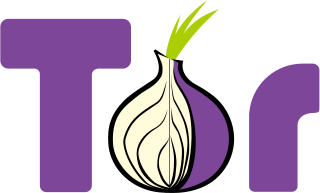Related Research Articles
The Domain Name System (DNS) is a hierarchical and distributed naming system for computers, services, and other resources in the Internet or other Internet Protocol (IP) networks. It associates various information with domain names assigned to each of the associated entities. Most prominently, it translates readily memorized domain names to the numerical IP addresses needed for locating and identifying computer services and devices with the underlying network protocols. The Domain Name System has been an essential component of the functionality of the Internet since 1985.
A top-level domain (TLD) is one of the domains at the highest level in the hierarchical Domain Name System of the Internet after the root domain. The top-level domain names are installed in the root zone of the name space. For all domains in lower levels, it is the last part of the domain name, that is, the last non empty label of a fully qualified domain name. For example, in the domain name www.example.com, the top-level domain is .com. Responsibility for management of most top-level domains is delegated to specific organizations by the ICANN, an Internet multi-stakeholder community, which operates the Internet Assigned Numbers Authority (IANA), and is in charge of maintaining the DNS root zone.
A name server is a computer application that implements a network service for providing responses to queries against a directory service. It translates an often humanly meaningful, text-based identifier to a system-internal, often numeric identification or addressing component. This service is performed by the server in response to a service protocol request.

In computer networking, a proxy server is a server application that acts as an intermediary between a client requesting a resource and the server providing that resource. It improves privacy, security, and performance in the process.
Dynamic DNS (DDNS) is a method of automatically updating a name server in the Domain Name System (DNS), often in real time, with the active DDNS configuration of its configured hostnames, addresses or other information.
An anonymous P2P communication system is a peer-to-peer distributed application in which the nodes, which are used to share resources, or participants are anonymous or pseudonymous. Anonymity of participants is usually achieved by special routing overlay networks that hide the physical location of each node from other participants.
The Invisible Internet Project (I2P) is an anonymous network layer that allows for censorship-resistant, peer-to-peer communication. Anonymous connections are achieved by encrypting the user's traffic, and sending it through a volunteer-run network of roughly 55,000 computers distributed around the world. Given the high number of possible paths the traffic can transit, a third party watching a full connection is unlikely. The software that implements this layer is called an "I2P router", and a computer running I2P is called an "I2P node". I2P is free and open sourced, and is published under multiple licenses.

A botnet is a group of Internet-connected devices, each of which runs one or more bots. Botnets can be used to perform Distributed Denial-of-Service (DDoS) attacks, steal data, send spam, and allow the attacker to access the device and its connection. The owner can control the botnet using command and control (C&C) software. The word "botnet" is a portmanteau of the words "robot" and "network". The term is usually used with a negative or malicious connotation.
DNS spoofing, also referred to as DNS cache poisoning, is a form of computer security hacking in which corrupt Domain Name System data is introduced into the DNS resolver's cache, causing the name server to return an incorrect result record, e.g. an IP address. This results in traffic being diverted to any computer that the attacker chooses.
In computing, the Hesiod name service originated in Project Athena (1983–1991). It uses DNS functionality to provide access to databases of information that change infrequently. In Unix environments it often serves to distribute information kept in the /etc/passwd, /etc/group, and /etc/printcap files, among others. Frequently an LDAP server is used to distribute the same kind of information that Hesiod does. However, because Hesiod can leverage existing DNS servers, deploying it to a network is fairly easy.

.onion is a special-use top level domain name designating an anonymous onion service, which was formerly known as a "hidden service", reachable via the Tor network. Such addresses are not actual DNS names, and the .onion TLD is not in the Internet DNS root, but with the appropriate proxy software installed, Internet programs such as web browsers can access sites with .onion addresses by sending the request through the Tor network.

Fast flux is a domain name system (DNS) based evasion technique used by cyber criminals to hide phishing and malware delivery websites behind an ever-changing network of compromised hosts acting as reverse proxies to the backend botnet master—a bulletproof autonomous system. It can also refer to the combination of peer-to-peer networking, distributed command and control, web-based load balancing and proxy redirection used to make malware networks more resistant to discovery and counter-measures.

Tor, short for The Onion Router, is free and open-source software for enabling anonymous communication. It directs Internet traffic via a free, worldwide, volunteer overlay network that consists of more than seven thousand relays.
Internet censorship circumvention, also referred to as going over the wall or scientific browsing in China, is the use of various methods and tools to bypass internet censorship.

Instantbird is a discontinued cross-platform instant messaging client based on Mozilla's XULRunner and the open-source library libpurple used in Pidgin. Instantbird is free software available under the GNU General Public License. Over 250 add-ons allow user customization of, and addition of, features. On October 18, 2017, Florian Quèze announced that "... we are stopping development of Instantbird as a standalone product."
Amazon Route 53 is a scalable and highly available Domain Name System (DNS) service. Released on December 5, 2010, it is part of Amazon.com's cloud computing platform, Amazon Web Services (AWS). The name is a possible reference to U.S. Routes, and "53" is a reference to the TCP/UDP port 53, where DNS server requests are addressed. In addition to being able to route users to various AWS services, including EC2 instances, Route 53 also enables AWS customers to route users to non-AWS infrastructure and to monitor the health of their application and its endpoints. Route 53's servers are distributed throughout the world. Amazon Route 53 supports full, end-to-end DNS resolution over IPv6. Recursive DNS resolvers on IPv6 networks can use either IPv4 or IPv6 transport to send DNS queries to Amazon Route 53.
DNSCrypt is a network protocol that authenticates and encrypts Domain Name System (DNS) traffic between the user's computer and recursive name servers. It was originally designed by Frank Denis and Yecheng Fu.

Tor2web is a software project to allow Tor hidden services to be accessed from a standard browser without being connected to the Tor network. It was created by Aaron Swartz and Virgil Griffith.

Ricochet or Ricochet IM is a free software, multi-platform, instant messaging software project originally developed by John Brooks and later adopted as the official instant messaging client project of the Invisible.im group. A goal of the Invisible.im group is to help people maintain privacy by developing a "metadata free" instant messaging client.
The Facebook onion address located at facebookwkhpilnemxj7asaniu7vnjjbiltxjqhye3mhbshg7kx5tfyd.onion is a site that allows access to Facebook through the Tor protocol, using its .onion top-level domain.
References
- ↑ V, Jesse (August 8, 2015). "[tor-dev] First release of OnioNS for beta testing". lists.torproject.org.
- ↑ "Jesse-V/OnioNS-client". GitHub . 25 October 2020.